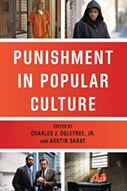Punishment in Popular Culture

Editors: Charles J. Ogletree, Jr. and Austin Sarat
Publisher: New York: New York University Press, 2015. 320p.
Reviewer: Mary Welek Atwell | January 2016
The subject of the book Punishment and Popular Culture is fascinating. How are punishments portrayed in various forms of popular media—movies, television dramas, reality TV, news reports and online sources? As the editors indicate, the chapters deal with why we punish, how we punish, and whom we punish. The “we” in that formulation is the United States. The “when” ranges from the 1930s to the first decades of the twenty-first century. As in many collected works, perhaps especially those that develop from conference presentations, the chapters in this book vary rather widely in subject matter, in style, and in their contribution to the larger question of how punishment mirrors political, cultural, and legal values. The contributors include historians, law professors, media studies professors, and undergraduates. The sources they analyze range from well-known and popular films and television to the relatively obscure “Locked Up Abroad,” a reality show featuring reenactments of experiences of Americans incarcerated in foreign prisons. It may be that the more familiar the examples, the more the arguments resonate with readers.
Given the variety of contributions to this volume, it seems wise to discuss each chapter separately and to conclude with some general statements about the collection. I will begin with the pieces that I found the most interesting and persuasive.
Kristen Whissel’s chapter analyzing the “spectacle of punishment and the melodramatic imagination” in two classic prison films was outstanding for both its concept and its argument. Whissel asserts that the films “I am a Fugitive from a Chain Gang” (1932) and “Brute Force” (1947)use melodramatic conventions to make a hidden world (the prison) visible and morally accountable. Both represent a conflict between the opposing goals of punishment—retribution and rehabilitation—through stories of individual prisoners subjected to unjust systems. Both are set in a time when prisoners were, in the words of the Supreme Court, “slaves of the state,” with no right to due process or freedom from cruel and unusual punishment. The exposure of the brutality within the closed correctional system involves the use of melodrama to astonish and to raise anxiety in the viewer. That anxiety might find its voice in calls to abolish the chain gang, a premodern mode of punishment. Whissel’s work establishes that the classic prison films use melodrama to make the still relevant point that whether modes of punishment are modern or premodern they conceal the potential for barbarism beneath their institutional veneer. Additionally these films leave the sense that the evils inherent in the system corrupt all who encounter them.
“Rehabilitating Violence: White Masculinity and Harsh Punishment in 1990s Popular Culture” by Daniel LaChance makes a nice companion piece for Whissel’s chapter. In an analysis of “The Shawshank Redemption,” “American History X,” and the HBO series “Oz,” LaChance argues (as do many other scholars) that the late twentieth century penchant for harsh punishment in the United States was inseparable from anxiety about race. However, he also relates the depiction of prison to anxiety over white masculinity. He makes a strong claim that the works he studied portray prisons as institutions that undermine a white male obsession with control. These films justify the violence associated with punishment as a necessary to the rehabilitation of the protagonists. The white men need to learn that they must abandon the power that goes with their racial and gender identity to be truly liberated. Essentially LaChance makes the case that these portrayals justify the physical violence associated with prison by showing it as a means to moral regeneration.
Many scholars and critics have considered “The Wire” as a text for studying race and criminal justice in contemporary America. Kristen Henning uses punishment theory to look at the program’s representation of incapacitation, retribution, rehabilitation, and deterrence through the experiences of its characters. She argues that “The Wire” offers a challenge to the notion that punishment is about giving offenders their just deserts. Rather, the series shows the moral and economic degradation that mass incarceration has brought to African American communities. It further interrogates the notion of individual moral culpability by putting unlawful behavior into a larger context beyond rational choice. There are story lines that raise questions about the definition of crime, the proportionality of sentencing, and the political context of criminal justice. The series is set in Baltimore and, given the recent events surrounding the death there of Freddie Gray while in police custody, the location seems disturbingly real.
Austin Sarat along with six Amherst students authored the chapter “Scenes of Execution: Spectatorship, Political Responsibility, and State Killing in American Film.” It is an inclusive piece that examines films from a 1895 scene portraying the execution of Mary Stuart to “The Conspirator” (2010) showing the death of Mary Surratt as punishment for the assassination of Abraham Lincoln. The authors discuss three “motifs of spectatorship” whereby viewers observe an execution. They may watch from the audience, they may be brought behind the scenes with the executioner, or they may even be put in the place of the man or woman being put to death. Here the film may evoke empathy with the dying person by showing his humanity. Ultimately participation in capital punishment through the experience of film gives rise to questions of participation in the actual implementation of the death penalty.
Amy Adler’s examination of the Abu Ghraib photographs also raises questions of participation and complicity. She claims that viewers looking at the scenes where Iraqi prisoners were being tortured by smiling American troops move between the perspectives of the torturers, the victims, the onlookers, and the photographers. She further claims that viewers experienced pleasure, desire, and complicity, as well as shame and disgust. Adler finds that the pictures fit into a popular culture where the spectacle of punishment as entertainment (what she terms “humilitainment”) was a staple of American reality TV. It is true that shows such as “Fear Factor” were very popular in 2001 and 2002 but it seems overstatement to generalize from that fact to acceptance of torture and humiliation in the real world. She further asserts that the Abu Ghraib photos evoked sadistic pleasure and gratification in viewers, based on a claim that the pleasure of watching punishment “is now the master narrative of reality TV . . .a template for contemporary culture.” This is indeed a very broad allegation. In addition, Adler applies Freud’s essay “A Child is Being Beaten” as a model for understanding responses to the pictures. Freud describes a common fantasy where patients told him of their reactions to imaginary beatings—reactions accompanied by erotic feelings. One can transfer this analysis to the viewers’ responses to the Abu Ghraib images, but it is impossible to either prove or disprove the validity of this scheme. Adler includes a rather significant caveat in a footnote. She writes about using the terms “I” and “we” to refer to the “ideal viewer” of the photos and then continues, “I do not mean to suggest that there is in any way a universal response to those photographs. Indeed there was great controversy surrounding them and what they mean.” (p. 251). One might argue that this caveat severely undermines the thesis of the entire article.
In “Better Here than There: Prison Narratives in Reality Television,” Aurora Wallace offers a discussion of “Locked Up Abroad,” a program on the National Geographic Channel that falls into the category she calls “prison porn” or sensationalized documentary. (I must admit that I never heard of this series although it apparently ran for eight seasons.) However, her chapter is interesting, even if one is unfamiliar with its subject. The conceit that plays out in each episode is that an American traveler runs afoul of the law while visiting another country. After being apprehended, the foolish adventurer is subjected a corrupt investigation and then sentenced to a primitive and violent prison. The stories are told, of course, through reenactments with a voice-over provided by the real individual. Wallace points out that the program is a product of Rupert Murdoch’s media empire and that its ideological orientation is clear. Although the American is guilty of breaking the law, he or she learns a lesson through the misery suffered as a consequence. Although the conditions of detention are overcrowded and often filthy, the time served is relatively short. Sometimes the prisoner even escapes. The offender always learns a lesson and vows to go straight in the future. Deterrence is clearly the message, although one could argue that maybe the rehabilitative effect is also valuable. In addition, “Locked Up Abroad” strongly suggests that criminal behavior is purely a matter of individual choice. As the conservative orientation of the network would imply, there is little or no attention to structural factors that encourage crime. And in another example of telling only part of the story, Wallace rightly points out that although the show portrays foreign prisons as hellish, it does not actually compare them to conditions in American prisons. There is no mention of whether the offenders who ended up in foreign prisons had access to the American consulate during their processing. It would be worthwhile to know if such access made a difference in the outcome.
The first and last chapters in the book are the most general and therefore seem to offer the most negligible contribution to the overall topic. “Redeeming the Lost War: Backlash Films and the Rise of the Punitive State” by Lary May provides an original, if largely unsupportable, explanation for the development of policies of harsh punishment in the latter decades of the twentieth century. His basic argument is that the loss of the Vietnam War led to a reaction—a series of movies with vigilante themes (the Dirty Harry, Death Wish, and Rambo series)—and those films helped to create an atmosphere for the adoption of harsh punishments. Certainly there is a relationship between foreign policy failures and the conservative “law and order” policies begun by the Nixon administration. But to put too much emphasis on the war and the films neglects the importance of race as a fear tactic used by conservatives to build political support. One could argue that the evidence supports (and most scholars emphasize) race and racial fears as overriding factors in the development of the punitive state.
Finally the last chapter, Brandon L. Garrett’s “Images of Injustice” differs from the other studies in that he assumes that popular culture influences our expectations about the criminal justice system. Without analyzing any particular examples from the popular media, he looks at three cases where innocent individuals were wrongfully convicted based on common assumptions about eyewitness testimony, junk science (bite identification), and false confessions. He suggests—and few would argue with him—that new social media, cell phones, and other technology will have an impact on the processing of crime. Garrett’s article, although he makes a cogent case, seems like it would be more at home in a different collection.
Overall, there is much to appreciate in this work. Punishment in Popular Culture is the most recent of the five books that Ogletree and Sarat have edited in their series on race and justice. That subject remains possibly the most important area of inquiry in the fields of criminal justice and legal studies. One hopes they will continue to host the conferences and to encourage the scholarship that contributes to our understanding of race and justice.
Mary Welek Atwell is Professor Emerita of Criminal Justice at Radford University


